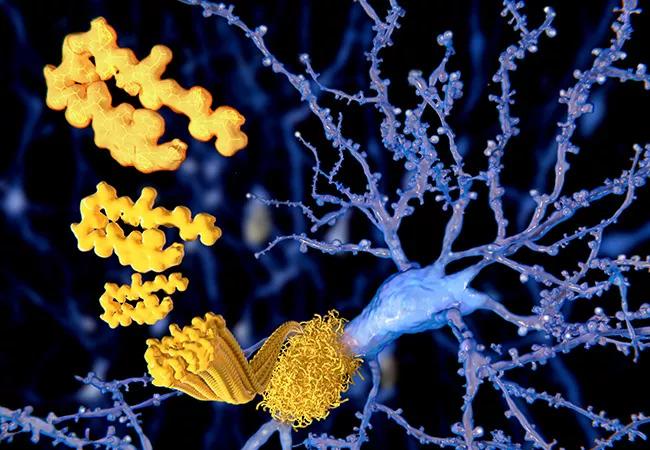Possible surrogate biomarker for AD subtype, retrospective study suggests

High cerebrospinal fluid (CSF) levels of the protein biomarker total tau correlate with an atypical presentation of Alzheimer’s disease (AD) involving language or behavioral changes as an early clinical sign. That’s the primary finding of a retrospective study of 70 patients with AD presented by Cleveland Clinic Lou Ruvo Center for Brain Health investigators in a poster session at the American Academy of Neurology’s 2017 annual meeting in Boston.
Advertisement
Cleveland Clinic is a non-profit academic medical center. Advertising on our site helps support our mission. We do not endorse non-Cleveland Clinic products or services. Policy
“It’s traditionally assumed that Alzheimer’s disease is a monolithic entity involving memory loss,” says neurocognitive scientist Jagan Pillai, MD, PhD, the study’s lead author. “The recognition of different biomarker patterns in CSF is really changing this picture and helping us understand the underlying basis of unusual presentations.”
AD does not present or progress in a uniform way, often making diagnosis a challenge. While the disease most commonly presents with memory loss that progresses over years, it sometimes manifests first with language difficulties or behavioral problems and can occasionally follow a rapid clinical course.
To aid AD diagnosis, amyloid protein is commonly measured by PET scan or in CSF, but patterns vary, and only autopsy can provide definitive confirmation. This problem has prompted a search for other markers that can assist in diagnosis and advance understanding of the underlying variability seen in AD.
Various other proteins in CSF, including total tau, phosphorylated tau and amyloid beta 42, are often used to support the diagnosis and to evaluate other causes of dementia. Among the biomarkers, total tau is thought to best reflect the intensity of neuronal damage, as it is mostly highly elevated in disorders with severe neuronal degeneration, such as Creutzfeldt-Jakob disease and acute stroke.
In general, total tau tends to be moderately elevated in AD, but this is not uniformly the case. Highly elevated total tau levels have been reported in rapidly progressive forms of AD.
Advertisement
Dr. Pillai’s newly presented study involved retrospective analysis of data from 70 patients who had CSF evaluation within three years of onset of AD symptoms. Data were obtained from 2013 to 2016 from the Cleveland Clinic Center for Brain Health Biobank at Lou Ruvo Center for Brain Health. As detailed in an earlier Consult QD post, the biobank stores fluid and tissue specimens characterized by patient demographic and medical details for use in research studies.
Of the 70 CSF samples studied, 14 had highly elevated total tau (> 1,000 pg/mL). These 14 patients were similar to the 56 patients with low total tau in terms of age, education, ApoE4 profile and AD symptom duration. However, patients with high total tau were more likely to have the following:
AD can have heterogeneous clinical presentations beyond memory loss, with language deficits, spatial perception deficits and behavioral changes serving as variant initial symptoms. Correlating the variants with biomarkers could aid in diagnosis, prognosis, monitoring of disease course and therapy response, and defining subpopulations in treatment trials. Dr. Pillai also points out that studies of biomarkers may provide clues as to “why Alzheimer’s disease behaves so differently in different people.”
Advertisement
This study indicates that elevated CSF total tau levels in patients with AD could potentially serve as an indicator for disease subtypes with predominant early cortical symptoms, i.e., language and behavior rather than memory loss. But Dr. Pillai notes that more study is needed to confirm and extend these findings before they are ready for clinical application.
Whether tau itself is a useful treatment target is uncertain, he adds, pointing out that it could just be an innocent bystander — a nonspecific marker of cell death. Clinical trials are underway to investigate this avenue of therapy.
“We are now advancing our understanding of different variants of Alzheimer’s disease,” Dr. Pillai adds. “Eventually we will not treat the disease generically but be able to target therapy to the different types.”
Advertisement
Advertisement

Multidisciplinary approach helps address clinical and psychosocial challenges in geriatric care

Effective screening, advanced treatments can help preserve quality of life

Study suggests inconsistencies in the emergency department evaluation of geriatric patients

Auditory hallucinations lead to unusual diagnosis

How providers can help prevent and address this under-reported form of abuse

How providers can help older adults protect their assets and personal agency

Recognizing the subtle but destructive signs of psychological abuse in geriatric patients

Early screening — and shorter boarding times — benefit older adults